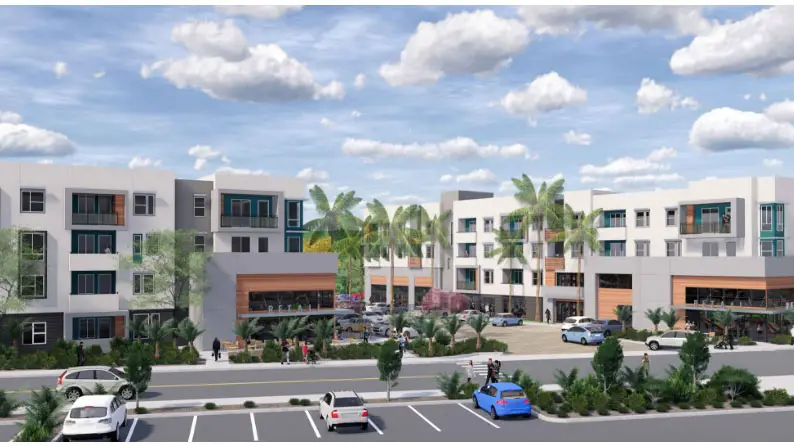OCEANSIDE — In the next few years, a 19-acre vacant lot neighboring the Fire Mountain residential area will be home to a 295-unit apartment complex with a handful of retail options.
The Oceanside Planning Commission on Oct. 10 approved the development of Ocean Creek, a residential project with apartments ranging from studio to three bedrooms and 30 dwelling units reserved for affordable housing.
The project will be developed on a 13-acre grading pad, leaving the remaining six acres primarily open space with some frontage area.
Although the project submitted a density bonus application, which by state law would allow a project to surpass local jurisdictional density limits if affordable housing is provided, the project opted not to increase the number of apartments beyond what local zoning allows.
Developer JPI did not request additional incentives or waivers as part of its density bonus application. However, the project did opt for smaller parking requirements under California’s density bonus law.
Under local requirements, a sizeable project would require 570 parking spaces, and the California density bonus law drops that requirement to 374 spots. Ocean Creek developers have asked for 476 parking spaces, with 10 reserved for its ground-floor retail options.
Developers explained that the apartment complex would be transit-oriented given its location right next to the Crouch Street Sprinter Station and access to local bus routes.
According to staff, the project meets many goals the city has already established for future development. City Planner Stefanie Cervantes said the project meets the purposes of the General Plan’s Energy and Climate Action Element: the project accommodates growth within an already urbanized area, it is consistent with the city’s Smart and Sustainable Corridor Plan, and it preserves and enhances local natural habitat of the nearby Loma Alta Creek.
Cervantes also pointed out that the project helps add to the city’s housing supply.
“The project provides additional rental housing stock within the city and is within the transit-oriented area that is served by the nearby Sprinter line and local bus routes,” Cervantes told the city’s planners. “The project helps the city meet the Regional Housing Needs Assessment, which assumes that the city will experience a demand of over 5,000 new units over the next eight years.”
Short-term rental housing will also be off-limits at Ocean Creek.
“It’s a great project for housing,” said Commissioner Louise Balma.
The developer also argued that the project would help alleviate the homeless encampments and activity in and around the vacant lot where the project would take over.
Despite the several boxes the project checks, many residents of Fire Mountain remain concerned that Ocean Creek will change the community’s character and worsen existing issues with local traffic.
The project proposes to connect the currently dead-end road of South Oceanside Boulevard, a completely different road that runs parallel to Oceanside Boulevard, to Crouch Street with a left turn lane to get onto South Oceanside Boulevard from Crouch.
This newly-connected road, according to developers, would provide an alternative access road to the freeway and further west along Oceanside Boulevard, away from the Crouch and Oceanside Boulevard intersection.
Residents are still worried about traffic effects going south along Crouch Street and through Fire Mountain neighborhoods past Lincoln Middle and Palmquist Elementary schools to get to Walmart and other large department stores.
“It will cause danger to and from Palmquist and Lincoln,” said Patsy Downs, a long-time Fire Mountain resident.
A local transportation study studied several intersections and street segments near the project throughout the neighborhood and found that only 15% or 461 trips will travel into and from the Fire Mountain neighborhood, which isn’t considered a significant increase by local traffic standards.
Commissioners approved the project in a 4-1 vote. Commissioner Jeff Symons refused to support the project because the effects of cut-through traffic through Fire Mountain to stores like Walmart and state Route 78 weren’t studied extensively enough.



